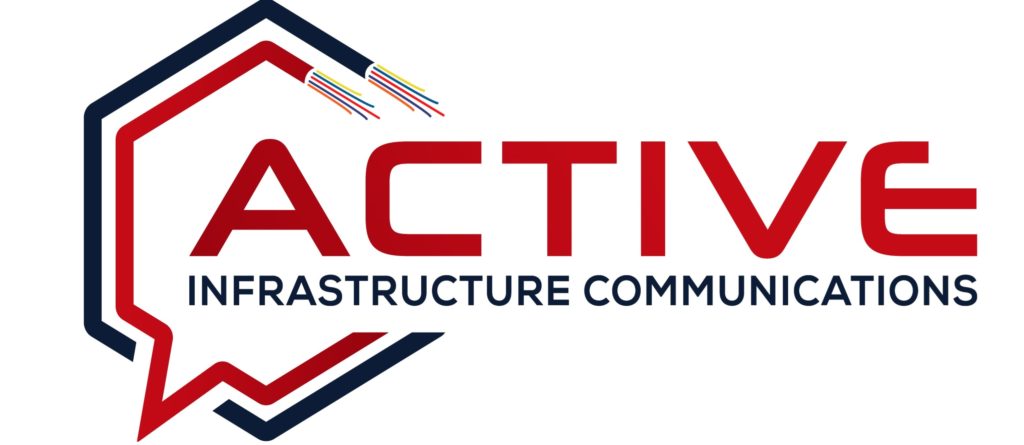Active Infrastructure Communications
Frequently Asked Questions
We Hope You Find What
You are Looking for.
Explore our Frequently Asked Questions!
- What is structured cabling? Structured cabling refers to a standardized architecture and components for data and voice communications within a building or campus. It provides a flexible and organized approach to cabling infrastructure.
- Why is structured cabling important? Structured cabling simplifies management, reduces downtime, and supports future growth by providing a unified infrastructure for all network-related activities.
- What are fiber optic cables? Fiber optic cables use strands of glass or plastic fibers to transmit data as pulses of light, offering high-speed and high-capacity transmission over longer distances compared to traditional copper cables.
- What are the advantages of fiber optic cables? Fiber optics offer higher bandwidth, lower attenuation (signal loss), immunity to electromagnetic interference, and greater security due to their physical properties.
- What is access control? Access control refers to security measures that restrict or grant access to resources or areas based on predefined rules and policies.
- What types of access control systems are available? Access control systems can range from simple key-based systems to advanced electronic systems using biometrics (fingerprint, iris scan) or RFID (radio-frequency identification) cards.
- What is video conferencing? Video conferencing enables real-time audio and video communication between multiple participants at different locations, facilitating virtual meetings and collaboration.
- What are the benefits of video conferencing? Video conferencing reduces travel costs, enhances communication and collaboration among remote teams, and improves decision-making processes.
- What are video surveillance cameras? Video surveillance cameras are devices used to monitor and record activities in specific areas for security and safety purposes.
- What features should I consider when choosing video surveillance cameras? Factors to consider include resolution (image quality), low-light performance, storage options (cloud vs. local), remote access, and integration with other security systems.
- What is data cabling? Data cabling refers to the infrastructure used to connect network devices and facilitate data transmission within a network.
- What are common types of data cables? Common types include twisted-pair cables (e.g., Cat5e, Cat6), fiber optic cables, and coaxial cables, each suited for different applications and environments.
- What is audio/visual (AV) technology? AV technology encompasses equipment and systems used for sound reproduction, video display, and multimedia presentations.
- What are examples of AV systems? Examples include projectors, displays (LCD, LED), audio systems, microphones, and control systems for managing AV equipment.
- What is sound masking? Sound masking involves adding a background sound, often white noise or pink noise, to reduce the intelligibility of speech and increase speech privacy in open office environments.
- What are the benefits of sound masking systems? Sound masking systems can improve acoustic comfort, increase confidentiality, and enhance productivity by reducing distractions and enhancing speech privacy.
- What are paging systems? Paging systems are used for broadcasting announcements or messages over speakers to specific areas or throughout a facility.
- What types of paging systems are available? Paging systems can be analog or digital and may include overhead paging, intercoms, and integration with other communication systems.
- What are managed services? Managed services refer to outsourcing IT operations to a third-party provider who assumes responsibility for managing and maintaining specified IT functions and systems.
- What are the advantages of managed services? Managed services can reduce IT costs, improve system performance and reliability, provide access to specialized expertise, and allow internal IT staff to focus on strategic initiatives.
- What is third-party subcontracting? Third-party subcontracting involves hiring external contractors or vendors to perform specific tasks or projects on behalf of a company.
- What considerations are important when subcontracting? It's essential to consider factors such as vendor reputation, service level agreements (SLAs), security protocols, and the ability to integrate subcontracted services seamlessly with existing operations.
- What are nurse call systems? Nurse call systems are communication systems used in healthcare settings to alert nurses or caregivers to patient requests or emergencies.
- What features should I look for in nurse call systems? Features may include integration with patient monitoring systems, mobile alerts, two-way communication, and reporting capabilities to enhance patient care and staff efficiency.
- What is a Distributed Antenna System (DAS)? A Distributed Antenna System is a network of antennas connected to a common source that provides improved wireless coverage and capacity within a defined area or building.
- When is a DAS system necessary? DAS systems are deployed in environments with high wireless traffic, such as stadiums, airports, hospitals, and large office buildings, to enhance cellular connectivity and performance.
- What are wireless solutions? Wireless solutions encompass technologies and systems that enable wireless communication, such as Wi-Fi networks, Bluetooth, and cellular networks.
- What factors should I consider when deploying wireless solutions? Considerations include coverage area, network capacity, security measures (encryption, authentication), scalability, and compatibility with existing infrastructure.
- What are service calls? Service calls refer to requests made to IT or technical support teams for assistance with troubleshooting, repairs, or maintenance of technology systems or equipment.
- How can I optimize service calls for efficiency? Optimizing service calls involves clear communication of issues, prioritization based on urgency, tracking and documenting resolutions, and proactive maintenance to prevent recurring issues.

These Frequently Asked Questions cover a broad range of topics related to technology infrastructure, communications systems, and IT services, providing foundational knowledge for understanding and addressing common inquiries in these areas.
